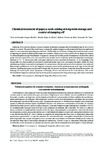Use este identificador para citar ou linkar para este item:
http://www.alice.cnptia.embrapa.br/alice/handle/doc/1003259Registro completo de metadados
| Campo DC | Valor | Idioma |
|---|---|---|
| dc.contributor.author | CAMPOS, S. de C. | pt_BR |
| dc.contributor.author | SILVEIRA, S. F. da | pt_BR |
| dc.contributor.author | SILVA, R. F. da | pt_BR |
| dc.contributor.author | VIANA, A. P. | pt_BR |
| dc.date.accessioned | 2014-12-20T08:57:09Z | - |
| dc.date.available | 2014-12-20T08:57:09Z | - |
| dc.date.created | 2014-12-19 | pt_BR |
| dc.date.issued | 2014 | pt_BR |
| dc.identifier.citation | Revista Ceres, v. 61, n. 3, p. 384-391, mai/jun., 2014 | pt_BR |
| dc.identifier.issn | 2177-3491 | pt_BR |
| dc.identifier.uri | http://www.alice.cnptia.embrapa.br/alice/handle/doc/1003259 | pt_BR |
| dc.description | Damping off is a nursery disease of great economic importance in papaya and seed treatment may be an effective measure to control. The aim of this work was to evaluate the quality of papaya seeds treated with fungicides and stored under two environmental and packaging conditions. Additionally, the efficiency of fungicide treatments in the control of damping-off caused by Rhizoctonia solani was evaluated. Papaya seeds were treated with the fungicides Captan, Tolylfluanid and the mixture Tolylfluanid + Captan (all commercial wettable powder formulations). Seeds of the control group were not treated. The seeds were stored for nine months in two conditions: packed in aluminum coated paper and kept at 7 ± 1°C and in permeable kraft paper and kept in non-controlled environment. At the beginning of the storage and every three months the seed quality (germination and vigor tests), emergence rate index, height, dry mass and damping of plants in pre and post-emergence (in contaminated substrate and mycelia-free substrate) were analyzed. Both storage conditions as well as the fungicide treatments preserved the germination and seed vigor. In the infested substrate, seedling emergence was favored by fungicides, but in post-emergence, fungicides alone did not control the damping off caused by R. solani. Symptoms of damping off were not observed in the clean substrate. The results showed that the fungicide treatments may be used to pretreat papaya seed for long-term storage and commercialization. | pt_BR |
| dc.language.iso | eng | eng |
| dc.rights | openAccess | eng |
| dc.subject | Fungicidas | pt_BR |
| dc.title | Chemical treatment of papaya seeds aiming at long-term storage and control of damping off. | pt_BR |
| dc.type | Artigo de periódico | pt_BR |
| dc.date.updated | 2014-12-20T08:57:09Z | pt_BR |
| dc.subject.thesagro | Tombamento | pt_BR |
| dc.subject.thesagro | Doença de planta | pt_BR |
| dc.subject.thesagro | Mamão | pt_BR |
| dc.subject.thesagro | Tratamento | pt_BR |
| dc.subject.thesagro | Thanatephorus Cucumeris | pt_BR |
| dc.subject.nalthesaurus | Fungicides | pt_BR |
| dc.subject.nalthesaurus | Damping off | pt_BR |
| riaa.ainfo.id | 1003259 | pt_BR |
| riaa.ainfo.lastupdate | 2014-12-19 | pt_BR |
| dc.contributor.institution | SILVIA DE CARVALHO CAMPOS BOTELHO, CPAMT; Silvaldo Felipe da Silveira, Centro de Ciências e Tecnologias Agropecuárias, Universidade Estadual do Norte Fluminense, Campos dos Goytacazes, Rio de Janeiro, Brasil.; Roberto Ferreira da Silva, Centro de Ciências e Tecnologias Agropecuárias, Universidade Estadual do Norte Fluminense, Campos dos Goytacazes, Rio de Janeiro, Brasil.; Alexandre Pio Viana, Centro de Ciências e Tecnologias Agropecuárias, Universidade Estadual do Norte Fluminense, Campos dos Goytacazes, Rio de Janeiro, Brasil. | pt_BR |
| Aparece nas coleções: | Artigo em periódico indexado (CPAMT)  | |
Arquivos associados a este item:
| Arquivo | Descrição | Tamanho | Formato | |
|---|---|---|---|---|
| cpamt2014botelhopapaya.pdf | 286,03 kB | Adobe PDF |  Visualizar/Abrir |









